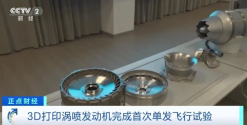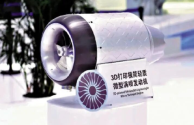China's 3D-printed engine achieves successful maiden flight, enabling a leapfrog development?
On November 13, it was learned from the Aero Engine Corporation of China that its independently developed 3D-printed minimalist lightweight micro turbojet engine recently completed its first single-engine flight test .It is understood that the 3D-printed turbojet engine, which successfully completed its flight, flew continuously for 30 minutes on a target drone , reaching an altitude of 6,000 meters and a speed of Mach 0.75 , with the engine operating normally and stably throughout the flight. These figures signify a major breakthrough in domestic aero-engine manufacturing and may have a profound impact on future aero-engine research and development models and the development of small aircraft.

The environment at an altitude of 6,000 meters is far from friendly. Under low temperature and low pressure conditions, the material properties of 3D printed parts face severe challenges. Details disclosed by the Chief Engineer's Office of the Institute of Dynamics and Motion Research show that the engine maintained combustion chamber stability in complex airflow, and the rotor components withstood fatigue tests at high speeds. These data are more convincing than ground tests . When the target drone platform flew at Mach 0.75, every parameter fluctuation was crucial to the success or failure of the test, and the conclusion of "no abnormalities in all working conditions" signifies that domestically produced 3D printing materials have broken through the key performance threshold .From a technical perspective, the breakthrough of this successfully flown 3D-printed turbojet engine lies primarily in two dimensions : design and manufacturing . In terms of design, this 160kg thrust-class micro turbojet engine employs multidisciplinary topology optimization technology for a minimalist design. By significantly reducing the number of parts , it achieves both lightweight construction and high performance . In terms of manufacturing, overthree-quarters of the engine's weightis achieved through 3D printing, encompassing all rotor components, reducing the weight of core components such as rotors by more than 30%. This not only reduces the number of parts and the engine's weight but also simplifies maintenance procedures. According to official data from Aero Engine Corporation of China (AECC), the adoption of additive manufacturing technologyn ot only reduced the number of parts by 80%butalso shortened the development cycle by 50%.

Globally, minimalism—the application of 3D printing technology in aero-engine development—has become a significant trend. Leading aerospace powers, such as the United States, are actively exploring the application of 3D printing technology in aero-engines through their military and industrial sectors, including companies like GE , aiming to shorten development cycles, reduce manufacturing costs, and achieve performance breakthroughs .
Therefore, China's breakthrough in the field of 3D-printed aero-engines is not only a successful technological experiment, but also an important milestone in the application of 3D printing technology in key aero-engine components . As the global aviation industry focuses on the disruptive label of "3D printing of three-quarters of the parts," this breakthrough may have a profound impact on the future development model of aero-engines and the development of small aircraft.
